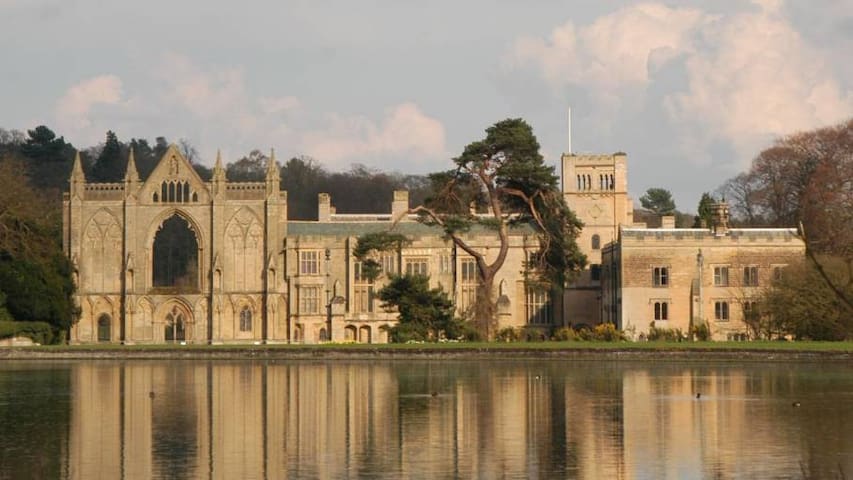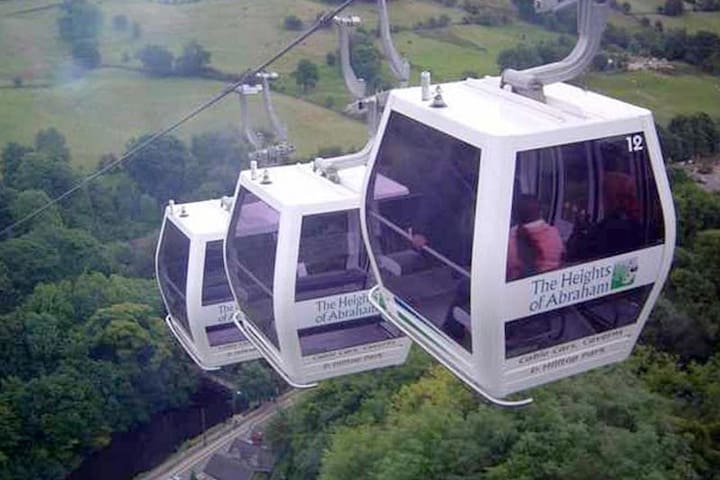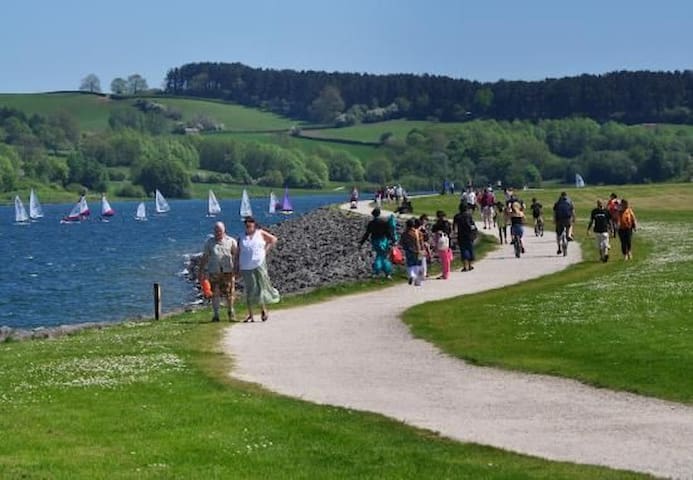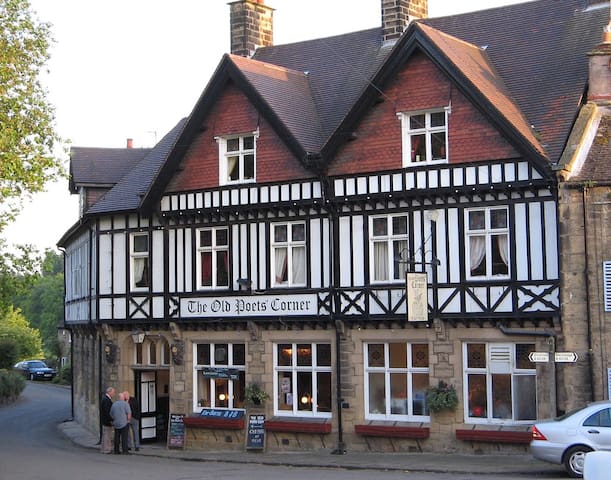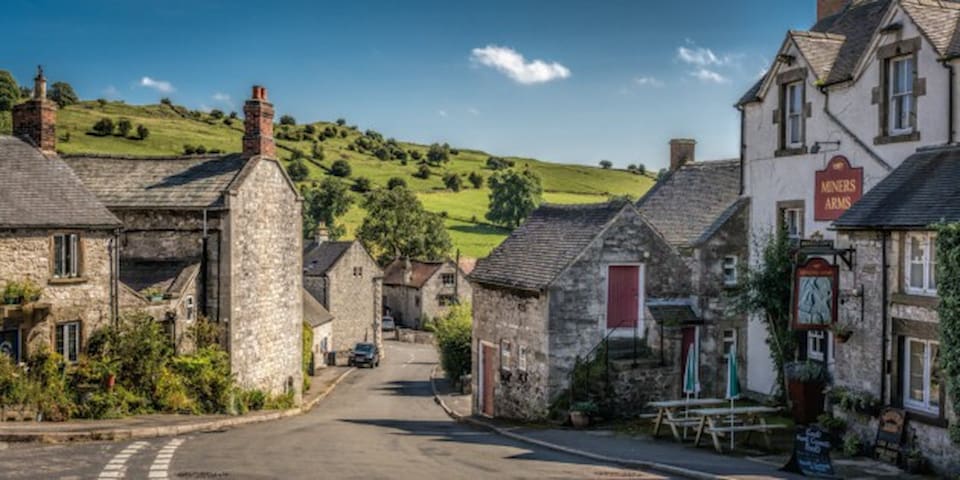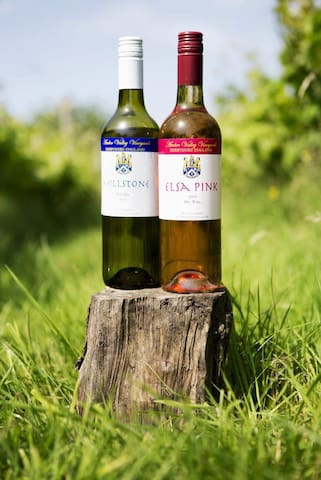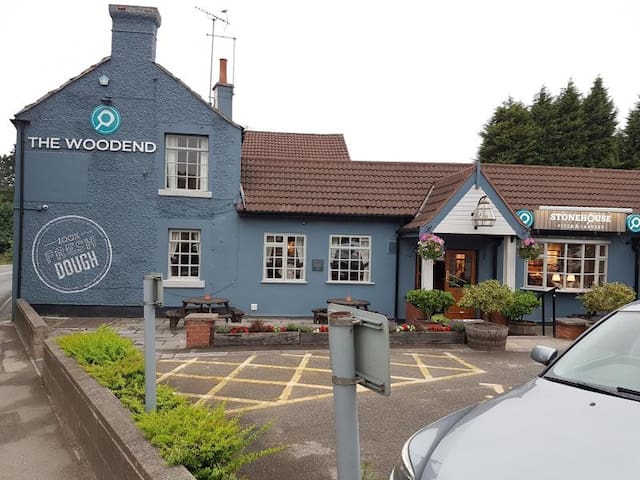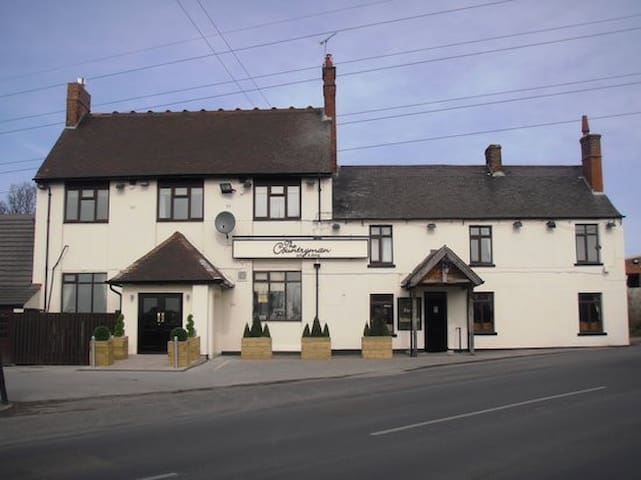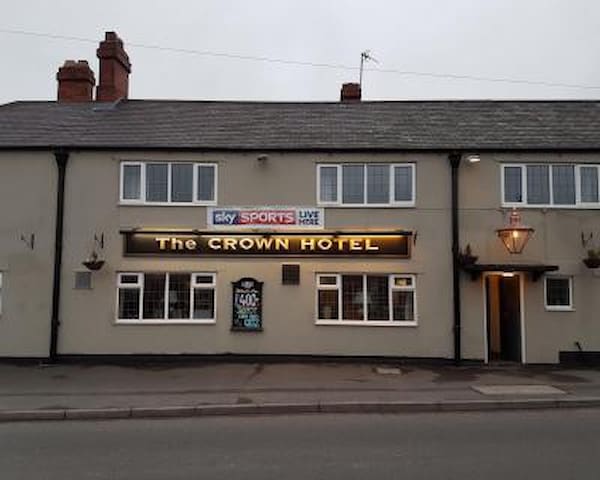Sightseeing
Chatsworth House is a stately home in Derbyshire, England, in the Derbyshire Dales 3.5 miles north-east of Bakewell and 9 miles west of Chesterfield. The seat of the Duke of Devonshire, it has been home to the Cavendish family since 1549.
698 habitants recommandent
Chatsworth House
Chatsworth House is a stately home in Derbyshire, England, in the Derbyshire Dales 3.5 miles north-east of Bakewell and 9 miles west of Chesterfield. The seat of the Duke of Devonshire, it has been home to the Cavendish family since 1549.
Hardwick Hall is an architecturally significant Elizabethan country house in England, a leading example of the Elizabethan prodigy house.
97 habitants recommandent
Confiance nationale - Hardwick Hall
Hardwick Hall is an architecturally significant Elizabethan country house in England, a leading example of the Elizabethan prodigy house.
Bolsover Castle is in the town of Bolsover. Built in the early 17th century, the present castle lies on the earthworks and ruins of the 12th-century.
50 habitants recommandent
Château de Bolsover
Castle StreetBolsover Castle is in the town of Bolsover. Built in the early 17th century, the present castle lies on the earthworks and ruins of the 12th-century.
Haddon Hall the private residence of Lord and Lady Edward Manners, with nine hundred years of history, it is one of the oldest houses in the country and moreover one of the only houses in England to have remained in one family’s ownership for its entire existence.
260 habitants recommandent
Haddon Hall
Haddon Hall the private residence of Lord and Lady Edward Manners, with nine hundred years of history, it is one of the oldest houses in the country and moreover one of the only houses in England to have remained in one family’s ownership for its entire existence.
Calke Abbey, like so many National Trust places, is a step back in time. But Calke is not presented like other country houses of its day. Paintwork is faded and peeling; vast collections of personal belongings are left as they were found. Here, the past is remarkably well preserved, in estate buildings, archaeology and the family’s belongings. From its roots as a religious priory, to its history as a family home for twelve generations, Calke Abbey tells many stories. Unpeeling these layer by layer, we can explore what life was like at Calke for the people who lived and worked here, and how this unique place was shaped by the wider world.
63 habitants recommandent
National Trust - Calke Abbey
Calke Abbey, like so many National Trust places, is a step back in time. But Calke is not presented like other country houses of its day. Paintwork is faded and peeling; vast collections of personal belongings are left as they were found. Here, the past is remarkably well preserved, in estate buildings, archaeology and the family’s belongings. From its roots as a religious priory, to its history as a family home for twelve generations, Calke Abbey tells many stories. Unpeeling these layer by layer, we can explore what life was like at Calke for the people who lived and worked here, and how this unique place was shaped by the wider world.
Newstead Abbey, in Nottinghamshire, England, was formerly an Augustinian priory. Converted to a domestic home following the Dissolution of the Monasteries, it is now best known as the ancestral home of Lord Byron.
54 habitants recommandent
Abbaye de Newstead
Newstead Abbey, in Nottinghamshire, England, was formerly an Augustinian priory. Converted to a domestic home following the Dissolution of the Monasteries, it is now best known as the ancestral home of Lord Byron.
Cromford Mill, the world’s first successful water powered cotton spinning mill, was built in 1771 by Sir Richard Arkwright.
From then until around 1790, he continued to develop the mills, warehouses and workshops, which now form the Cromford Mills site. Considered as a whole it presents a remarkable picture of an early textile factory complex.
However, problems with the water supply around 1840 imposed severe limitations on textile production at Cromford Mill and the buildings were put to other uses. These included a brewery, laundries, and cheese warehousing.
Finally, in 1922, the site was used as a colour works, producing colour pigments for paints and dyes. It is remarkable that so many of the buildings survived this use and, by 1979 when the Cromford Colour Works abandoned the site, many of them were heavily contaminated with lead chromate.
It was generally believed the mills had reached the end of their useful life and must be demolished – all of the key buildings had fallen into disrepair and many of the historic features of the site, including the principal watercourse, had been obliterated by modern development. So degraded had the site become that the Local Authorities believed it had lost too much of its original integrity that it was no longer historically important.
It was not until the modern buildings had been cleared away and new historical and archaeological research had been completed that the true value of the site was recognised. This reappraisal led to an upgrading of the listing and the entire site now enjoys Grade I status and is part of the Derwent Valley Mills World Heritage Site.
67 habitants recommandent
Moulin de Cromford
Mill RoadCromford Mill, the world’s first successful water powered cotton spinning mill, was built in 1771 by Sir Richard Arkwright.
From then until around 1790, he continued to develop the mills, warehouses and workshops, which now form the Cromford Mills site. Considered as a whole it presents a remarkable picture of an early textile factory complex.
However, problems with the water supply around 1840 imposed severe limitations on textile production at Cromford Mill and the buildings were put to other uses. These included a brewery, laundries, and cheese warehousing.
Finally, in 1922, the site was used as a colour works, producing colour pigments for paints and dyes. It is remarkable that so many of the buildings survived this use and, by 1979 when the Cromford Colour Works abandoned the site, many of them were heavily contaminated with lead chromate.
It was generally believed the mills had reached the end of their useful life and must be demolished – all of the key buildings had fallen into disrepair and many of the historic features of the site, including the principal watercourse, had been obliterated by modern development. So degraded had the site become that the Local Authorities believed it had lost too much of its original integrity that it was no longer historically important.
It was not until the modern buildings had been cleared away and new historical and archaeological research had been completed that the true value of the site was recognised. This reappraisal led to an upgrading of the listing and the entire site now enjoys Grade I status and is part of the Derwent Valley Mills World Heritage Site.
Matlock Bath is known as a tourist destination, with attractions including the Heights of Abraham Park, Gulliver's Kingdom theme park, the Peak District Mining Museum, the former Life in a Lens Museum of Photography & Old Times, the Grand Pavilion and an aquarium. On Sunday mornings the main street is lined with motor bikes stopping to chat and drink coffee, it’s quite a sight, the bikers come from all over and it’s become a popular meeting place.
155 habitants recommandent
Matlock Bath
Matlock Bath is known as a tourist destination, with attractions including the Heights of Abraham Park, Gulliver's Kingdom theme park, the Peak District Mining Museum, the former Life in a Lens Museum of Photography & Old Times, the Grand Pavilion and an aquarium. On Sunday mornings the main street is lined with motor bikes stopping to chat and drink coffee, it’s quite a sight, the bikers come from all over and it’s become a popular meeting place.
With its winding cobbled streets, welcoming Market Place and handsome Tudor and Georgian heritage, picturesque Ashbourne is known as 'The Gateway to Dovedale'.
Take a leisurely walking tour around town to immerse yourself in its fascinating history and architecture.
With more than 200 listed buildings - including historic almshouses, fine coaching inns and genteel town houses - it's a visual feast for the discerning visitor. Don't miss the splendid facade of the Grade I listed Old Grammar School, the 'longest inn sign in the world' at The Greenman public house on St John Street; or the beautiful St Oswald's Parish Church with its striking 212 feet high spire, described by classic author George Eliot as the 'finest single spire in England'.
Another highlight is the 17th century mansion, once home to the 'King of Ashbourne', Dr. John Taylor, where Lichfield-born Dr. Samuel Johnson, author of the first-ever English dictionary, was a frequent visitor in the 1700s.
Ashbourne also has some fascinating foodie links. The original recipe for Ashbourne Gingerbread was acquired from French prisoners of war - in particular the personal chef of a captured French general - who were kept in the town during the Napoleonic wars (1799-1815).
The timber-framed Gingerbread Shop - now a Birds Bakery - can still be seen in St John Street and the Original Ashbourne Gingerbread can be purchased locally.
Shopping is pure pleasure thanks to its plethora of small, family-run businesses and weekly open-air market. Browse for fine antiques, quality food and drink, designer fashion and much more, then relax over morning coffee, lunch or afternoon tea in a selection of cafés, inns and tea rooms.
Ashbourne is also famous for its ancient tradition of Royal Shrovetide Football - 'turned up', or started, by such famous figures as Prince Charles, Sir Stanley Matthews and The Duke of Devonshire. Played each Shrovetide Tuesday and Ash Wednesday, it's a unique and unruly event that bears little resemblance to the modern game!
Walkers, cyclists and horse riders will appreciate the fact that the town also sits at the start of the traffic-free Tissington Trail - a green gateway to Dovedale and the Pennine Bridleway, linking up further north with the popular High Peak Trail.
148 habitants recommandent
Ashbourne
With its winding cobbled streets, welcoming Market Place and handsome Tudor and Georgian heritage, picturesque Ashbourne is known as 'The Gateway to Dovedale'.
Take a leisurely walking tour around town to immerse yourself in its fascinating history and architecture.
With more than 200 listed buildings - including historic almshouses, fine coaching inns and genteel town houses - it's a visual feast for the discerning visitor. Don't miss the splendid facade of the Grade I listed Old Grammar School, the 'longest inn sign in the world' at The Greenman public house on St John Street; or the beautiful St Oswald's Parish Church with its striking 212 feet high spire, described by classic author George Eliot as the 'finest single spire in England'.
Another highlight is the 17th century mansion, once home to the 'King of Ashbourne', Dr. John Taylor, where Lichfield-born Dr. Samuel Johnson, author of the first-ever English dictionary, was a frequent visitor in the 1700s.
Ashbourne also has some fascinating foodie links. The original recipe for Ashbourne Gingerbread was acquired from French prisoners of war - in particular the personal chef of a captured French general - who were kept in the town during the Napoleonic wars (1799-1815).
The timber-framed Gingerbread Shop - now a Birds Bakery - can still be seen in St John Street and the Original Ashbourne Gingerbread can be purchased locally.
Shopping is pure pleasure thanks to its plethora of small, family-run businesses and weekly open-air market. Browse for fine antiques, quality food and drink, designer fashion and much more, then relax over morning coffee, lunch or afternoon tea in a selection of cafés, inns and tea rooms.
Ashbourne is also famous for its ancient tradition of Royal Shrovetide Football - 'turned up', or started, by such famous figures as Prince Charles, Sir Stanley Matthews and The Duke of Devonshire. Played each Shrovetide Tuesday and Ash Wednesday, it's a unique and unruly event that bears little resemblance to the modern game!
Walkers, cyclists and horse riders will appreciate the fact that the town also sits at the start of the traffic-free Tissington Trail - a green gateway to Dovedale and the Pennine Bridleway, linking up further north with the popular High Peak Trail.
Attractions fun for all the family
The Heights of Abraham is a tourist attraction in Matlock Bath, It consists of a hilltop park on top of Masson Hill, accessed from the village by either the Heights of Abraham cable car or a steep zig-zag path. The heights are named after a supposed resemblance to the Plains of Abraham. Amongst the attractions in the park, which has been open since Victorian times, are cavern and mine tours. There are also views of the dramatic scenery of the valley of the River Derwent.
160 habitants recommandent
Les hauteurs d'Abraham
Dale RoadThe Heights of Abraham is a tourist attraction in Matlock Bath, It consists of a hilltop park on top of Masson Hill, accessed from the village by either the Heights of Abraham cable car or a steep zig-zag path. The heights are named after a supposed resemblance to the Plains of Abraham. Amongst the attractions in the park, which has been open since Victorian times, are cavern and mine tours. There are also views of the dramatic scenery of the valley of the River Derwent.
Gulliver's Kingdom is a theme park aimed at children aged 3 to 13 in the town of Matlock Bath.
110 habitants recommandent
Gulliver's Kingdom Resort
Temple WalkGulliver's Kingdom is a theme park aimed at children aged 3 to 13 in the town of Matlock Bath.
Based in Staffordshire Theme Park is home to another world of adventure. Approx 1 hour drive from Tibhelf.
From play areas for small children, to white knuckle rides for thrill seekers, we’ve got over 40 rides and attractions to enjoy! Browse our rides including record-breaking rollercoasters and the UK’s only CBeebies Land.
329 habitants recommandent
Alton Towers
Farley LaneBased in Staffordshire Theme Park is home to another world of adventure. Approx 1 hour drive from Tibhelf.
From play areas for small children, to white knuckle rides for thrill seekers, we’ve got over 40 rides and attractions to enjoy! Browse our rides including record-breaking rollercoasters and the UK’s only CBeebies Land.
Carsington Water is a reservoir operated by Severn Trent Water located between Wirksworth and Kniveton in Derbyshire, England. The reservoir takes water from the River Derwent at Ambergate during winter months, pumping up to the reservoir by 10.5-kilometre (6.5 mi) long tunnels and aqueduct. Water is released back into the river during summer months for water abstraction and treatment further downstream. It is England's ninth largest reservoir with a capacity of 35,412 megalitres.[1]
Planning for the reservoir started in the 1960s with actual construction starting in 1979. In 1984 there was a partial collapse of the dam prior to its filling. The dam was subsequently completely removed before construction of a new dam commenced in 1989. The finished reservoir was opened by Queen Elizabeth II in 1992.[1]
The reservoir is a major centre for leisure activities including walking, cycling, fly fishing, birdwatching, sailing, canoeing, and windsurfing. The land surrounding the reservoir, in particular the facilities around the visitor centre, has played host to events including a music festival, the Festival of the Peak.
163 habitants recommandent
Carsington Water
Carsington Water is a reservoir operated by Severn Trent Water located between Wirksworth and Kniveton in Derbyshire, England. The reservoir takes water from the River Derwent at Ambergate during winter months, pumping up to the reservoir by 10.5-kilometre (6.5 mi) long tunnels and aqueduct. Water is released back into the river during summer months for water abstraction and treatment further downstream. It is England's ninth largest reservoir with a capacity of 35,412 megalitres.[1]
Planning for the reservoir started in the 1960s with actual construction starting in 1979. In 1984 there was a partial collapse of the dam prior to its filling. The dam was subsequently completely removed before construction of a new dam commenced in 1989. The finished reservoir was opened by Queen Elizabeth II in 1992.[1]
The reservoir is a major centre for leisure activities including walking, cycling, fly fishing, birdwatching, sailing, canoeing, and windsurfing. The land surrounding the reservoir, in particular the facilities around the visitor centre, has played host to events including a music festival, the Festival of the Peak.
Other villages
One of the prettiest villages in Derbyshire, Ashover has a fascinating 15th century church, many historic buildings and stunning surrounding countryside. Many pubs to choose from for lunch / dinner or just a drink and watch the world go by
Ashover lies in the valley of the River Amber, about half way between Chesterfield to the North and Matlock to the South. It has a long history dating back to the Saxons who called the village 'Essovre' - beyond the ash trees. The Domesday Book credited it with a church, a priest, several ploughs and a mill, with a taxable value.
10 habitants recommandent
Ashover
One of the prettiest villages in Derbyshire, Ashover has a fascinating 15th century church, many historic buildings and stunning surrounding countryside. Many pubs to choose from for lunch / dinner or just a drink and watch the world go by
Ashover lies in the valley of the River Amber, about half way between Chesterfield to the North and Matlock to the South. It has a long history dating back to the Saxons who called the village 'Essovre' - beyond the ash trees. The Domesday Book credited it with a church, a priest, several ploughs and a mill, with a taxable value.
An attractive old village set in the rocky limestone uplands of the southern White Peak.
Away from main roads, Brassington has a timeless feel to it. Set on a hilltop and surrounded by spectacular countryside, the fine Norman church of St James overlooks the village where there are some lovely old houses and pretty cottages set amongst narrow streets. Once an important centre for lead mining, there are still many remnants of the old industry to be seen in the area and some mineral extraction continues nearby.
Things to do; There are two very fine old inns providing refreshments. A fantastic area for outdoor enthusiasts, nearby is the High Peak Trail, the former Cromford and High Peak Railway now converted for use by walkers and cyclists. The routes of the Limestone Way and Midshires Way footpaths also pass close by. The area is rich in wildlife and for the geologist there are many fascinating rock formations, such as Harborough and Rainster Rocks. Carsington Water, with its' visitor centre and water sports is just to the south.
Brassington
An attractive old village set in the rocky limestone uplands of the southern White Peak.
Away from main roads, Brassington has a timeless feel to it. Set on a hilltop and surrounded by spectacular countryside, the fine Norman church of St James overlooks the village where there are some lovely old houses and pretty cottages set amongst narrow streets. Once an important centre for lead mining, there are still many remnants of the old industry to be seen in the area and some mineral extraction continues nearby.
Things to do; There are two very fine old inns providing refreshments. A fantastic area for outdoor enthusiasts, nearby is the High Peak Trail, the former Cromford and High Peak Railway now converted for use by walkers and cyclists. The routes of the Limestone Way and Midshires Way footpaths also pass close by. The area is rich in wildlife and for the geologist there are many fascinating rock formations, such as Harborough and Rainster Rocks. Carsington Water, with its' visitor centre and water sports is just to the south.
Food scene
Scheduled tours are led by Barry, Amber Valley Vineyards owner and vigneron at our Little Vineyard in Wessington, which overlooks the beautiful Amber Valley. Explore the vineyard year, the trials and tribulations of growing vines in Derbyshire. Tastings then follow in the glorious Orchard or in our quaint old stables Cellardoor tasting rooms if the weather isn't quite up to it. By a warming fire if it's inclement out!
Doehole Vineyard - Amber Valley Wines
A615Scheduled tours are led by Barry, Amber Valley Vineyards owner and vigneron at our Little Vineyard in Wessington, which overlooks the beautiful Amber Valley. Explore the vineyard year, the trials and tribulations of growing vines in Derbyshire. Tastings then follow in the glorious Orchard or in our quaint old stables Cellardoor tasting rooms if the weather isn't quite up to it. By a warming fire if it's inclement out!
5 minutes drive from Lime Trees on the edge of Hardwick Hall grounds. Serves traditional food.
The Hardwick Inn
5 minutes drive from Lime Trees on the edge of Hardwick Hall grounds. Serves traditional food.
About a 10 minute drive, popular tapas style eating pub/restaurant.
12 habitants recommandent
Pesto At The Peacock
1 Chesterfield RdAbout a 10 minute drive, popular tapas style eating pub/restaurant.
5 minute drive from Tibshelf, The Stonehouse pizza pub and carvery, Cheap and cheerful.
The Woodend - Stonehouse
Chesterfield Road5 minute drive from Tibshelf, The Stonehouse pizza pub and carvery, Cheap and cheerful.
10-15 minutes drive. A mixture of traditional English food and food from all around the world, booking recommended.
The Hunloke Arms
Derby Road10-15 minutes drive. A mixture of traditional English food and food from all around the world, booking recommended.
Approx 20 minutes drive. Food served all day from 11am. Very nice traditional food.
The Countryman Pub and Dining
Park Lane
Approx 20 minutes drive. Food served all day from 11am. Very nice traditional food.
5-10 Minutes drive is The Carnarvon pub, traditional modern food. It can be found in Fackley Rd,Teversal, Sutton in
Ashfield NG17 3JA booking recommended 01623 559676.
The Carnarvon
5-10 Minutes drive is The Carnarvon pub, traditional modern food. It can be found in Fackley Rd,Teversal, Sutton in
Ashfield NG17 3JA booking recommended 01623 559676.
5 Minutes drive is The Red Lion local country pub in the heart of Shirland. A hub of the local community and passers alike, the pub has a warm character, log burner, & charm.
They are well-known for their juicy burgers, hearty pies, curries & Sunday roast. There's plenty to discover behind the bar as well, with Real ales being their speciality!
21 habitants recommandent
The Red Lion
Main Street5 Minutes drive is The Red Lion local country pub in the heart of Shirland. A hub of the local community and passers alike, the pub has a warm character, log burner, & charm.
They are well-known for their juicy burgers, hearty pies, curries & Sunday roast. There's plenty to discover behind the bar as well, with Real ales being their speciality!
The Old Greyhound in Higham, Main Road, Old Higham Village, DE55 6EF approx 10 minute drive but well worth it! Traditional food and Vegan menu, roasts, lunch and dinner. Telephone 01773 832016
Higham
The Old Greyhound in Higham, Main Road, Old Higham Village, DE55 6EF approx 10 minute drive but well worth it! Traditional food and Vegan menu, roasts, lunch and dinner. Telephone 01773 832016
There are two pubs within walking distance, The Crown and The Twisted Oak. Turn left out of the close, walk for about 50-100 metres and they can be found on the opposite side of the road.
Tibshelf
There are two pubs within walking distance, The Crown and The Twisted Oak. Turn left out of the close, walk for about 50-100 metres and they can be found on the opposite side of the road.
What’s on…..
Hall Leys Park
Victorian Christmas Market, starts 3rd December 2021

